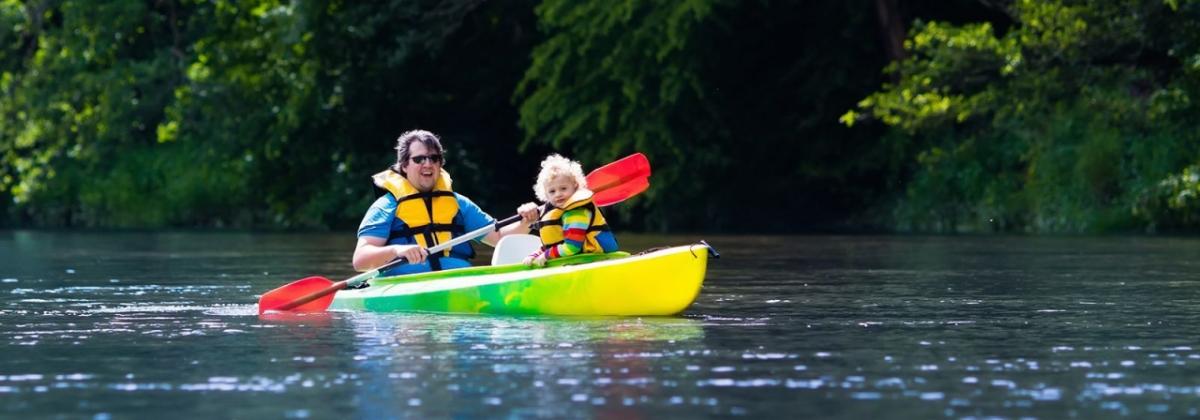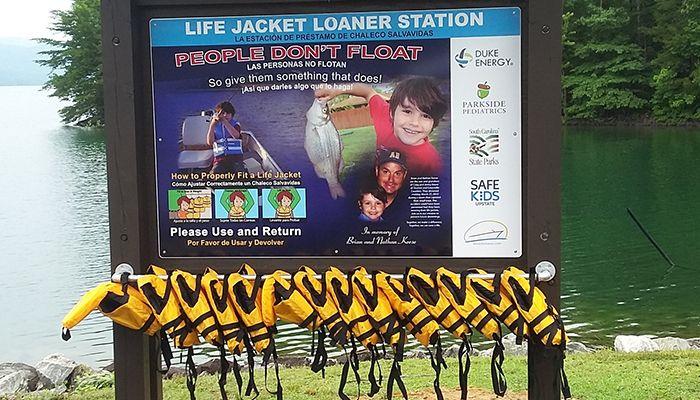Duke Energy Offers Free Life Jackets on Rivers and Lakes in the Carolinas
Like a seatbelt, a life jacket has to be worn to be useful. Every summer, Scott Jolley goes on a mission to ensure boaters and swimmers understand the importance of wearing a life jacket.
Jolley runs Duke Energy’s free life jacket loan program in North Carolina and South Carolina. Life jacket loaner stations are at more than 20 locations at lakes, rivers and creeks, and Jolley's team plans to add more each year.
The loaner program sprang from tragedy. Craig Keese’s son, Brian, and 8-year-old grandson, Nathan, drowned in 2010 in a boating accident in Missouri. Although neither was wearing a life jacket when their boat capsized in a storm, a child’s life jacket was found onboard.
Keese, an agricultural-chemical executive from Greenville, S.C., wanted to turn the family’s loss into something positive. For years, Duke Energy has worked with him and his wife, Jenny, to offer loaner life jackets to boaters and swimmers.
Duke Energy builds and installs the loaner stations and buys some of the jackets. The company also works with donors and community groups to acquire them. A child’s life jacket can range from $4 to $12 – they’re cheaper when bought in bulk, as Jolley strives to do – and that’s a small investment to make in something that can save a life.
Visitors borrow them on the honor system. “Some life jackets do have a way of walking off,” Jolley said. “But it almost evens out. We’ve had folks leave their own life jackets at our stations as a donation. They can appear out of nowhere.”
Safety in Spanish
The signs on the kiosks are only effective if swimmers and boaters can understand them. All signs have a universal message in English and Spanish about water safety and the importance of life jackets.
“All these incidents could have been prevented if life jackets were being worn," Jolley said. "Duke Energy is working with the N.C. Wildlife Resources Commission and the S.C. Department of Natural Resources on ways to help educate non-native English speakers about boater and swimming safety. We want to do all we can to prevent a tragedy.”
North Carolina’s boating law requires anyone younger than 13 to wear a life jacket when on a “recreational vessel” that’s moving. “Anyone riding a personal watercraft or being towed by one must also wear an appropriate life jacket,” according to the N.C. Wildlife Resources Commission website.
“Accidents can happen quickly and without warning,” said Major Chris Huebner, the state's boating safety coordinator says on the website. “There often isn’t time to grab a life vest and put it on properly before you are in the water. The best preparation is to wear it whenever you are underway.”
Don’t forget that kids outgrow life vests the way they do clothes and shoes. If you’re buying a life jacket for your child, check for a U.S. Coast Guard-approved label; match it to the child’s current weight and make sure it is snug but comfortable.
It’s the law to have one life jacket per person on your boat. “If you have 16 people on your pontoon boat, you’re required to have 16 life jackets,” Jolley said. And if children are on board, you need a proper-fitting life jacket for them. Jolley recommends adults wear theirs, too.
Jolley points out that life jackets have come a long way since some of us were kids. He doesn’t call them “stylish,” but he notes that the big collar is a thing of the past. “People used to complain they were cumbersome, and they were,” he said. “They’re much better fitted and comfortable now.”
But making a fashion statement isn’t the point. Saving your life is.
Water safety tips
- Never swim alone in a pool or a lake.
- Lakes can change. Water conditions are not the same everywhere, and neither is water depth. The lake bottom can change depth quickly.
- Don’t discount fatigue. Swimming and the sun can sap your energy. A life jacket can buoy you when you’re more tired than you realize.
- Monitor alcohol use. Drinking and boating (or swimming) is like drinking and driving. Alcohol also dehydrates you. When you’re drinking alcohol and in the sun, you’ll feel tipsy faster. Be cautious.
- Designate someone to stay on shore. We’re used to designating a driver. Use the same idea when swimming. Someone from your group should remain on shore or on the dock while the rest of the group is swimming. That person should have throw rings ready. You and your group can take turns being the spotter.
- Recognize the importance of the simple life jacket. Fewer people know how to swim today than a generation ago. Scott Jolley said: “If you can’t swim but you do wear a life jacket, you’re still in good shape.”
Life jacket loaner sites
- Catawba-Wateree Lakes (NC and SC)
- Lake Norman: Beattys Ford Access Area.
- Mountain Island Lake: Riverbend Access Area, Neck Road Access Area.
- Lake Wylie: Buster Boyd Access Area, Ebenezer Access Area, South Point Access Area.
- Lake Wateree: June Creek Access Area, Taylors Creek Access Area, Colonel’s Creek Access Area, Wateree Creek Access Area, Lugoff Access Area, Whiteoak Creek Access Area.
- Keowee-Toxaway Lakes (SC)
- Lake Keowee: South Cove Access Area, High Falls Access Area Mile Creek Park Access Area.
- Lake Jocassee: Devil’s Fork State Park.
- Nantahala Lakes (NC)
- Lake Glenville: Pines Recreation Area.
- Tuckasegee River Main Stem: East LaPorte, Locust Creek, Dillsboro (Scotts Creek), Barkers Creek.
- Bear Lake: Bear Lake Access Area.
- Duke Energy Progress Lakes (NC)
- Hyco Lake: Hyco Lake Park Swimming Area.



